“The intelligence of the battery does not lie in the cell but in the complex battery system.”, says Dieter Zetsche, CEO of Mercedes.
Quick Summary:
This blog focuses on the key components of battery management system that are best suited to meet the challenges of including battery safety, performance & longevity while designing a robust and smart BMS.
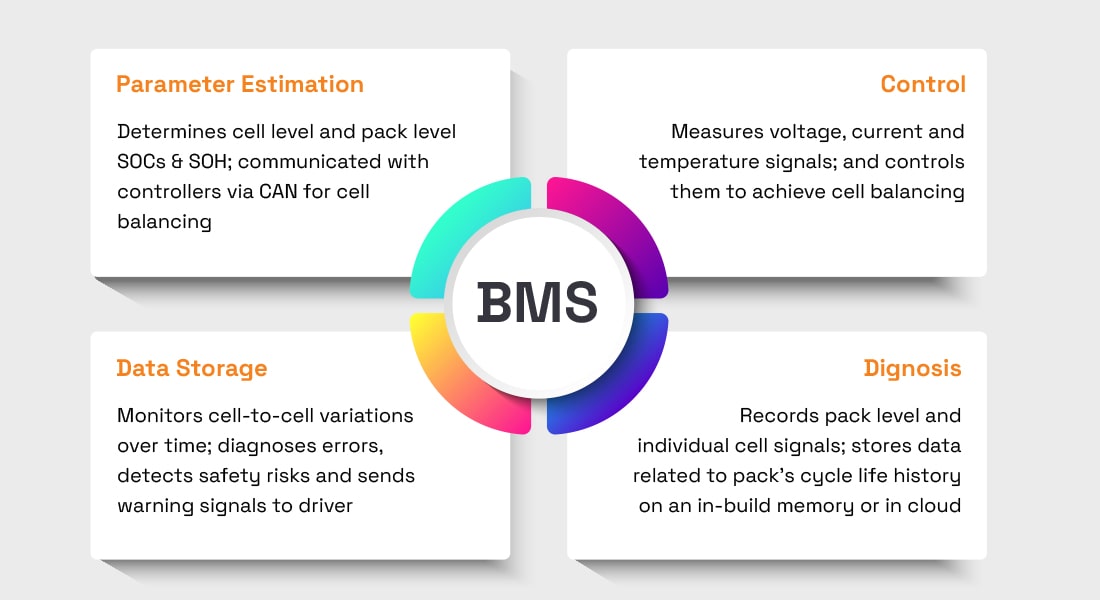
Table of Contents
Introduction
The Union Budget 2022-23 has induced a rapid momentum in the EV market for the customers, manufacturers, and dealers. EV market players are aware that adopting Battery-as-a-Service (BaaS) is significantly going to reduce the capital costs of buying an electric vehicle to about 30-50%.
Certainly, the battery swapping policy will facilitate the EV market to acquire a larger share as more and more electric scooters, cars, buses, and cargo trucks will be driven on the roads. As a result, power designers will face the challenge of delivering systems that can be adapted to a wide variety of batteries and vehicles with vastly diverse performance requirements. Just like the human brain, which controls the whole functioning of our body, a battery management system (BMS) is the brain behind the EV battery pack.
A battery management system has electronic components and a combination of functions and features necessary to meet the battery pack’s safety and operational requirements. BMS looks after the battery’s SOC (State Of Charge) so that it remains in a predefined range and it scans the change in its SOH (State Of Health). This functioning strategy involves shielding from high currents and large temperature variations.
Let us understand the key components of battery management system, different parts of battery management system, and battery management system architecture diagram.
The Importance of Battery Management System
Battery Management System is the chief in command for performing critical operations in a battery pack and provides the following functionality:
- Voltage, Current, and Temperature control and measurement
- SOC and SOH assessment
- Detection of fault
- Passive cell balancing
- Data storage
Check out our customized BMS product range as per your battery pack arrangement.
With Bacancy’s BMS, you can maximize your Lithium-ion battery safety, performance, and longevity.
Analyzing the Components of Battery Management System for EV
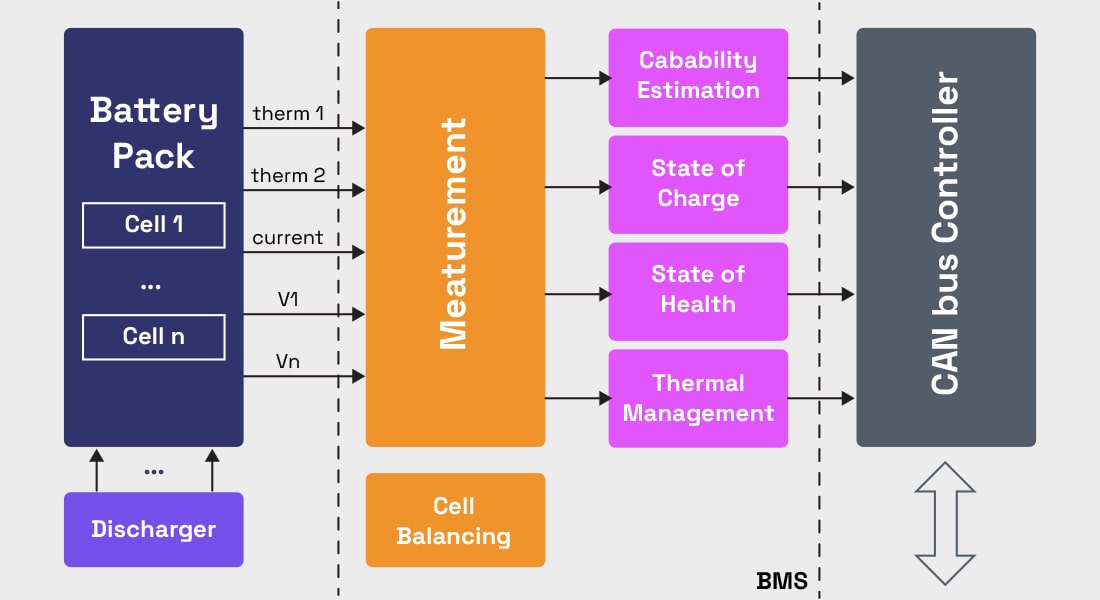
Fig: Battery Management System architecture diagram
Mainly, there are 6 components of battery management system.
1. Battery cell monitor
2. Cutoff FETs
3. Monitoring of Temperature
4. Cell voltage balance
5. BMS Algorithms
6. Real-Time Clock (RTC)
Let’s look at the significance and the application of each components of battery management system:
1. Battery cell monitor
A battery cell monitor primarily monitors the voltages for battery systems. It is a high-speed system that offers a low overall cost for high voltage measurements.
- The easiest way to determine the battery pack’s charge is to monitor individual cell voltage with reference to the set voltage level.
- When the voltage of the first cell reaches the voltage limit, the charging automatically trips. It indicates that the battery charging limit has been reached.
- If the battery pack has a lesser charge than the average cell, then the least charged cell will reach the limit first, and the rest of the cells will be left partially charged.
2. Cutoff FETs
FET driver is accountable for connection and isolation between load and charger of the battery pack. The behavior prediction is done through voltage, current measurements, and real-time detection circuitry.
- They can be connected to a battery pack’s low or high side.
- NMOS FETs activation is needed for enabling high-side connection and requires a charge pump driver. A reference for the solid ground is set using a high-side driver for the rest of the circuitry.
- We use a low-side FET driver to reduce costs in integrated solutions since a charge pump is not needed. High voltage devices are not required in such cases.
- The ground connection of the battery pack floats using low-side cut-off FETs. This can affect the IC performance, making it more sensitive to insinuated noise measurement.
3. Monitoring of Temperature
With the increase in product requirements, the batteries have been on a constant surge in delivering currents at fixed voltages. The continuous operation processes may cause a catastrophic event such as fire or explosion.
- We can identify whether battery charging or discharging is desirable using temperature measurements.
- Temperature sensors monitor the energy storage system or cell grouping for compact portable applications.
- The circuit temperature is monitored by the internal ADC voltage-powered thermistor. Employing the internal voltage reference helps reduce the temperature inaccuracies and improves the overall measurement system.
4. Cell voltage balance
It is crucial to determine the health of the battery pack. That is why cell voltage monitoring is done to ensure that the cells are in a proper running condition for attaining a long battery life.
- The operating voltage ranges from 2.5V to 4.2V in a lithium-ion battery.
- The battery life is significantly affected while performing battery operations beyond the voltage range. This reduces the life of a cell, which may even make it unfit for use.
- Connecting the battery pack in parallel increases the overall drive current, whereas series connection adds the overall voltage.
5. BMS Algorithms
To make quick and effective decisions in real-time based on the information received. For this purpose, a microcontroller for battery management system is needed to collect, organize and assess the information from the sensing circuitry.
- Renesas’ ISL94203 is the most famous example of employing a battery management system algorithm. It is a standalone digital solution embedded in a single chip with programmable capabilities.
- The memory space and microcontroller for battery management system clock cycles can be cleared using these standalone solutions.
6. Real-Time Clock
Allowing the user to know the battery pack’s behavior before any alarming event, the real-time clock acts as a black box system for time-stamping and memory storage.
- The BMS electronics is kept away from synchronizing with a third-party battery pack through battery authentication.
- The peripheral power circuitry is used around the components of battery management system through voltage reference/regulator.
How does Battery Management System work?
The battery management system tracks the status of each cell in the battery pack. Determining the SOC (State of Charge) and SOH (State of Health) helps estimate the amount of current needed for a safe charge and discharge operation without harming the battery.
The current limits act as a cut-off and prevent the battery from overcharging. This safeguards the cell voltages of the battery pack from high or low fluctuations, which immunes the battery life.
The BMS consistently tracks the charge and discharge activities for the battery pack and monitors cell voltages. This data is useful in deciding if the battery is drained, sustaining passive cell balancing.
The CAN (Controller Area Network) bus is the reliable unit for internal communications, driving most of the messaging protocols. The IEM (Intelligent Electric Meter) estimates the state parameters of the battery pack, total current, and battery pack voltage. It transfers the information to the CMU (Central Monitoring Unit) or the sub-controller unit.
The sub-controller unit quickly checks the temperature and voltage signals and sends data to the CAN bus. The BCU (Battery Control Unit) obtains the signals from the CAN bus and responds by transmitting back the control signals required in battery pack managing and modeling.
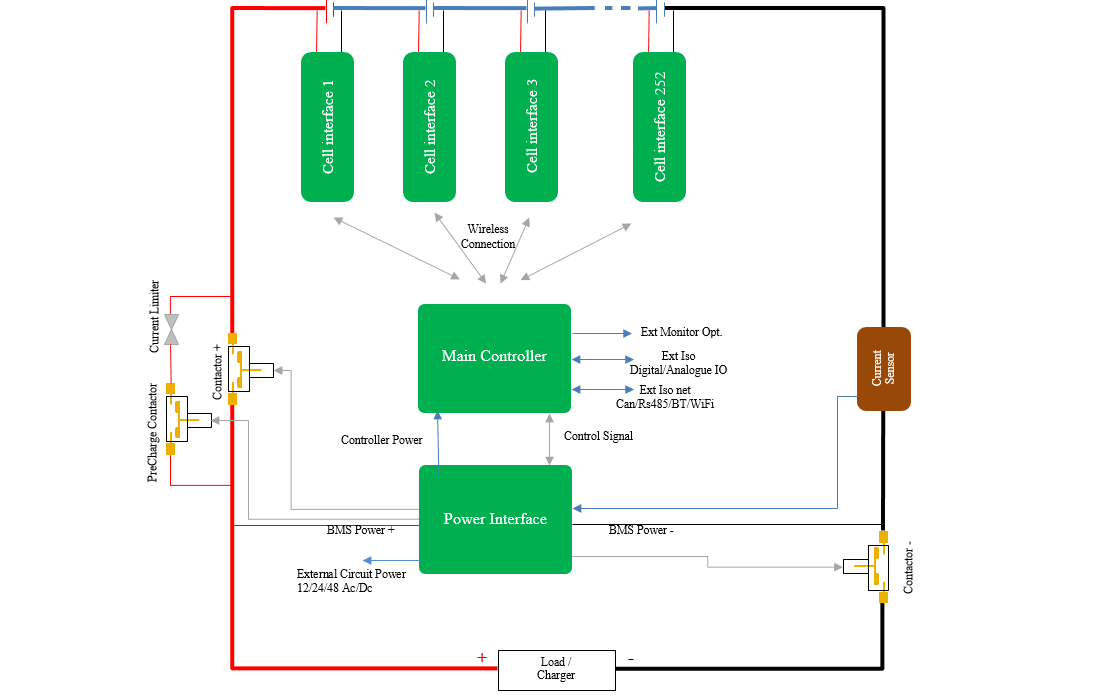
Fig: Battery Management System layout
Explore how Bacancy can help you build a high performing electric vehicle, e-rickshaw/scooter battery with long-lasting battery life.
Get in touch with the Leading Product Engineering Company
Types of Battery Management Systems:
Based on the topology of the battery packs, there are 4 types of battery management systems. They are:
Centralized Battery Management System Architecture:
It is clear in the figure below, that all the battery packages are connected directly with the central BMS.
Advantages of Centralized BMS
1. Compactness
2. Feasibility
Disadvantages of a Centralized BMS
The more the number of batteries, the more the number of ports required to support the same, leading to many wiring, cabling, and connectors. It can cause complications while troubleshooting and maintenance.
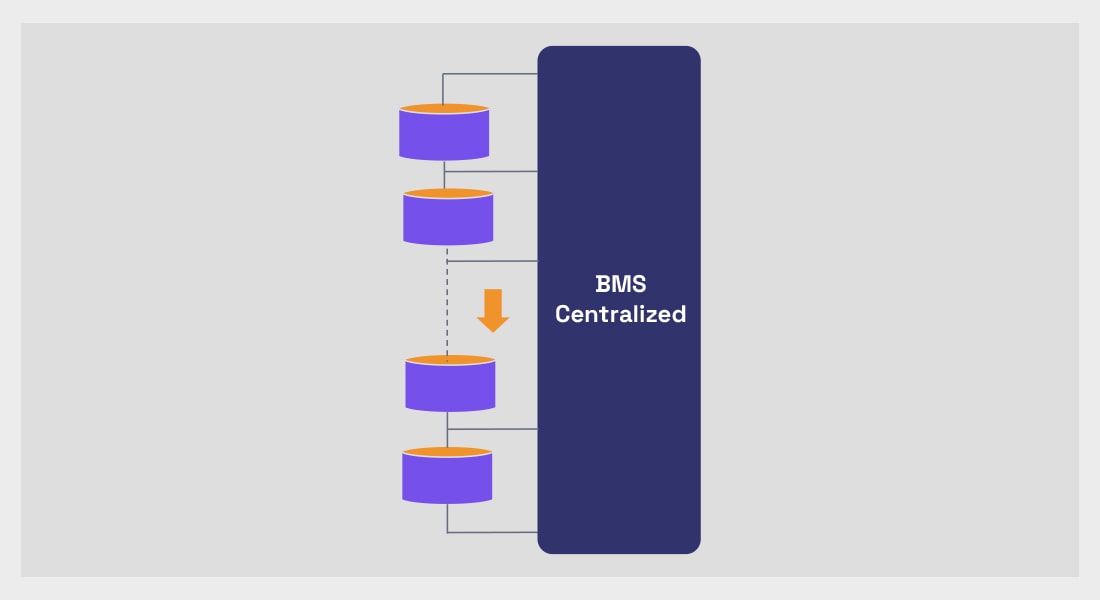
Modular Battery Management System:
The BMS is grouped into various duplicate modules, just like the centralized implementation wherein every module is associated with a separate wire bundle and connect to the battery pack’s adjacent assigned portion.
Advantages of Modular BMS
1. Reduces computational efforts
2. Increases the room for adding more functionalities
Disadvantages of a Modular BMS
1. Higher overall costs
2. Duplicated unused functionalities as per application
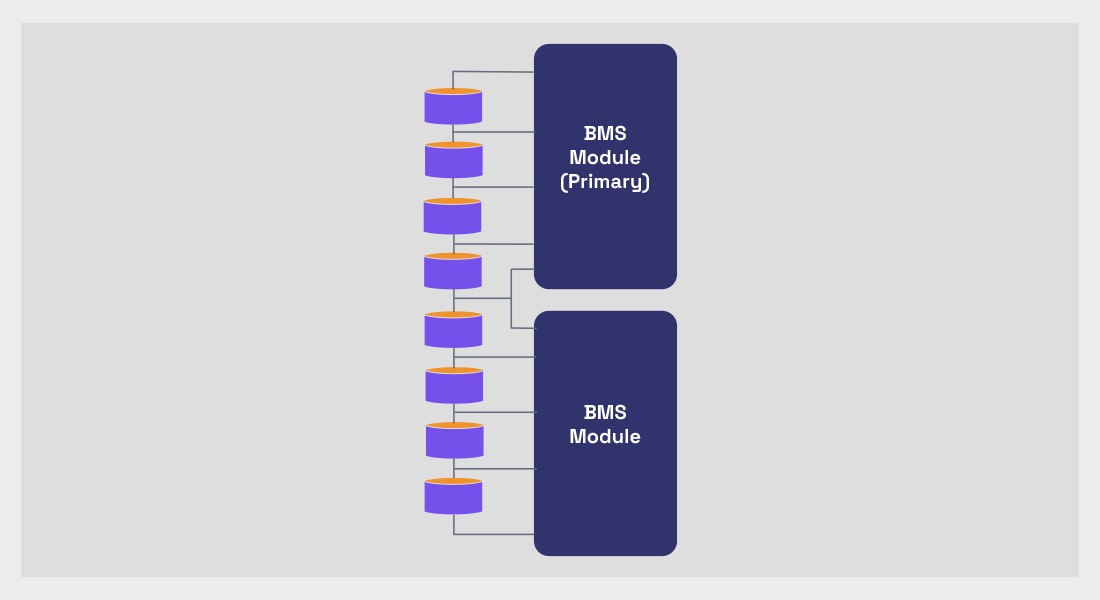
Primary Battery Management System:
The concept is almost similar to the modular topology, but here, slaves are more confined to just transferring measurement information, and the master is assigned for computation, control, and external communication.
Advantages of Primary Battery Management System
1. Lower costs
2. Simpler functionalities
Disadvantages of Primary Battery Management System
1. Less feature options
2. Not suitable for scaling operations

Distributed Battery Management System Architecture:
The architecture of distributed battery management system comprises of modules wherein the software and hardware is embedded in the form of modules attached through wiring. All the electronic hardware is synchronized with the cell or module under monitoring on a control board.
Advantages of Distributed Battery Management System
1. Reduces cable bundling
2. Autonomously handles communications and processing
Disadvantages of Distributed Battery Management System
1. High maintenance
2. Higher cost
3. Difficult to troubleshoot because of its deep routing
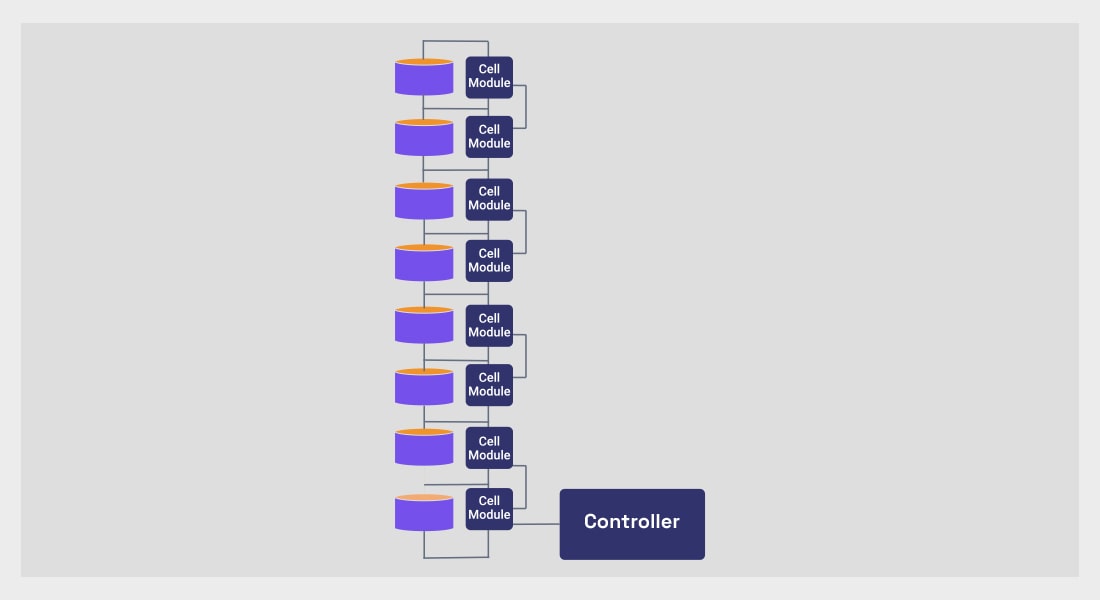
IoT based Battery Management System
The advent of cloud computing and the Internet of Things (IoT) has assured the EV industry that testing and product development have a long way to go. Through an IoT based battery management system, having high data storage capabilities, computation time, and efforts decrease exponentially. All the data captured during the battery operations can be analyzed and seamlessly transmitted to the cloud platform.
Through advanced diagnostic algorithms, the data is measured by battery pack sensors, analyzing the state of each battery cell. With big data collection in a single base, the battery management system algorithms for machine learning can attain system prediction and optimizations, revolutionizing our approach towards battery life cycle and performance.
Additionally, the BMS’s reliability increases by substituting wired communication with wireless IoT communication.
Here are the 4 major benefits of employing IoT for battery management systems
1. Remote monitoring
Consistent monitoring and maintaining the accuracy of the battery state through advanced diagnostic algorithms, equipped with high power in computation.
2. Lifecycle prediction
Accurate prediction of the trends in depletion with machine learning based on full life-cycle operation data.
3. Fault prediction and detection
Timely system fault detection of different levels through big data analysis increases system safety and reliability.
4. Evaluation and optimization
Optimize the design for the systems and adopt operation strategies by assessing the big data from battery systems through different operation cases.
Smart BMS Cloud Analytics Tools
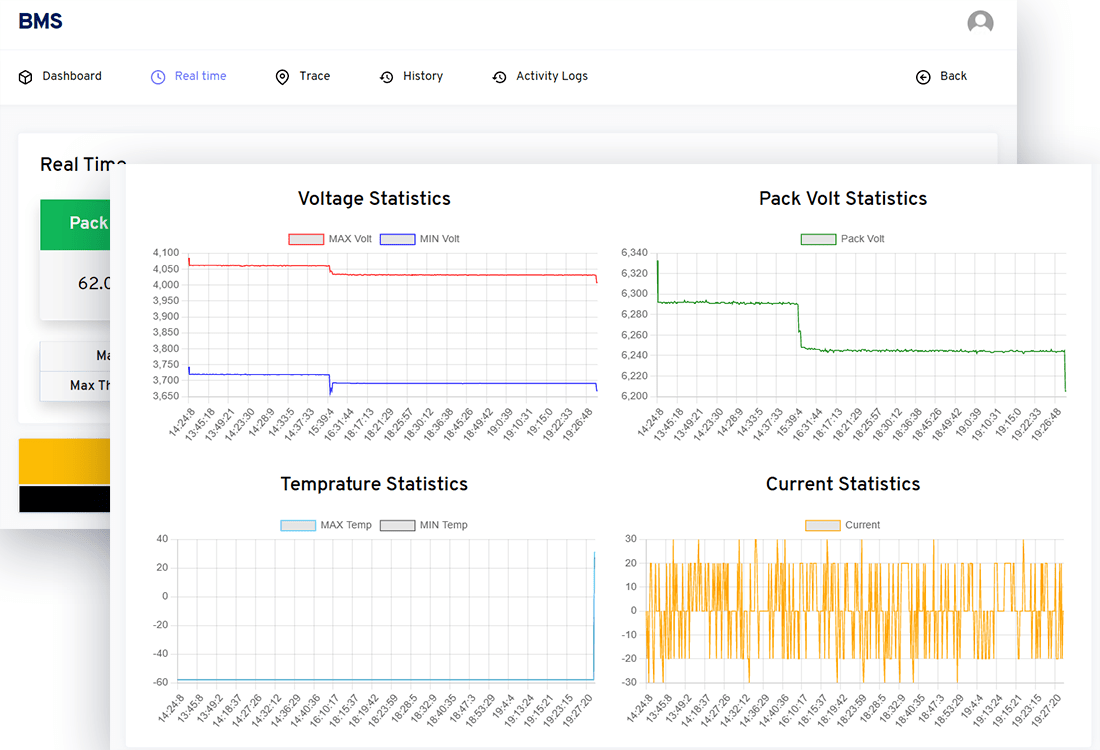
IONDASH (iondash.io battery cloud platform) is Bacancy’s secured platform for cloud battery analysis which facilitates the remote mirroring of battery status.
This smart BMS offers:
- Model: BMS-16S-xxA, BMS-22S-xxA)
- Inputs for the 16/22 cells connection
- 4 temperature sensors
- Extra input/outputs IO
It is an IoT cloud battery management system using which the battery can be inspected and monitored. The presence of an in-built fuse circuit protection protects the battery pack against any unwanted voltage and current spikes.
With our smart BMS, manufacturers can develop efficient battery modeling architecture and assembly, and also, the operators can anticipate failure detection to prevent downtimes.
Conclusion
So, that was all about exploring the components of battery management system from my side. I hope this blog has added value from an informative point of view. By now, you would have been convinced that the cloud battery management system has been developed based on the Internet of Things and cloud computing concept to future-proof the battery systems. Bacancy’s smart BMS is India’s most trusted solution for electric cars, scooters, e-bikes, and rickshaws.
Bacancy’s extended venture Bacancy Systems, is at the forefront in Product Engineering, design, and development. Bacancy Systems is catering to the E-mobility industry by delivering cutting-edge solutions to create future-ready products, such as the battery management system, motor controller, and CCS2 controller.
Frequently Asked Questions (FAQs)
Bacancy’s smart BMS has both maximum charge and discharge rates. The magnitude of the discharge protects the BMS, whereas the charge intensity protects the battery. For instance, if your battery specs state a charge limit of 0.5C, a 100AH BMS should be set at 50A.
The BMS controls the motor driver and the charger to protect the battery. It is worth repeating that a large pack BMS cannot protect the pack by itself. All it can do is request that the current be reduced or stopped.
BMS acts as a power controlling unit preventing sudden abruption in load current to affect lithium cells. Further, the loading transients range in milliseconds and effectively avoid high discharge rates. The electric vehicle is a subset of the vehicle. Therefore, it needs a fuel gauge.
Your Success Is Guaranteed !
We accelerate the release of digital product and guaranteed their success
We Use Slack, Jira & GitHub for Accurate Deployment and Effective Communication.


